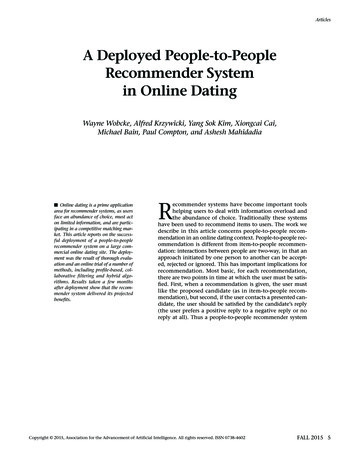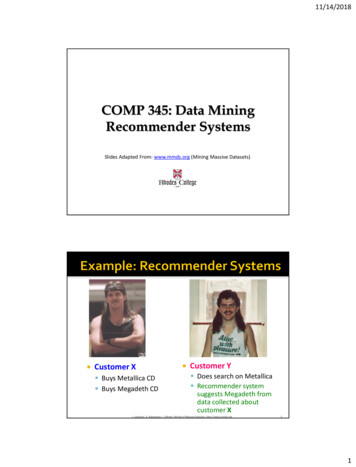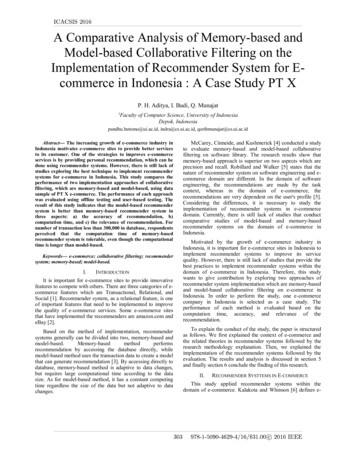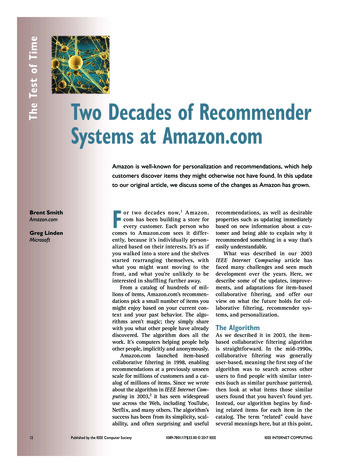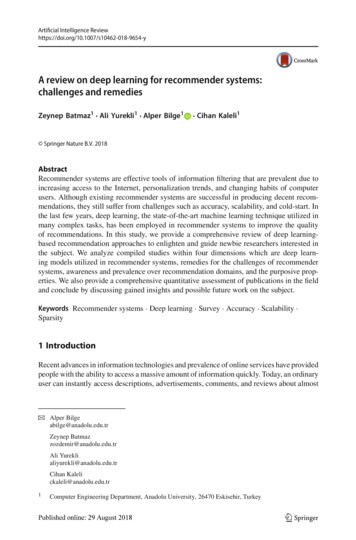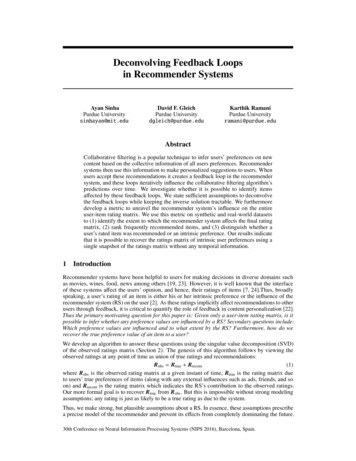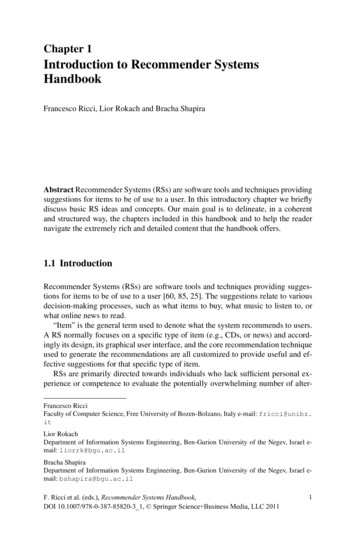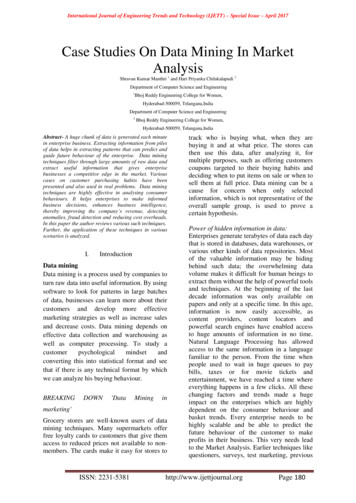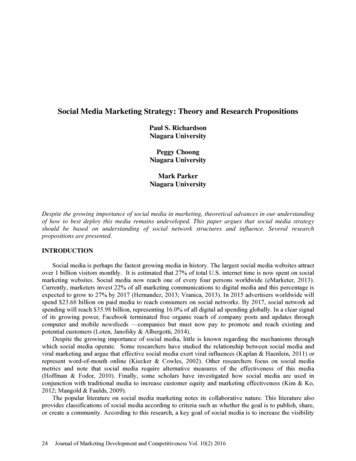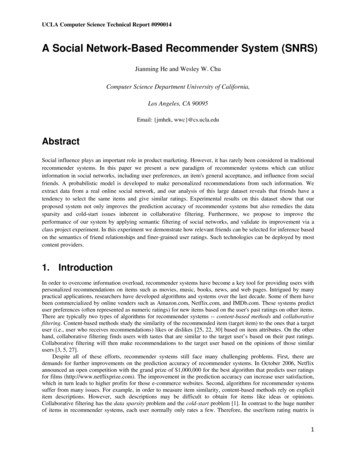
Transcription
UCLA Computer Science Technical Report #090014A Social Network-Based Recommender System (SNRS)Jianming He and Wesley W. ChuComputer Science Department University of California,Los Angeles, CA 90095Email: {jmhek, wwc}@cs.ucla.eduAbstractSocial influence plays an important role in product marketing. However, it has rarely been considered in traditionalrecommender systems. In this paper we present a new paradigm of recommender systems which can utilizeinformation in social networks, including user preferences, an item's general acceptance, and influence from socialfriends. A probabilistic model is developed to make personalized recommendations from such information. Weextract data from a real online social network, and our analysis of this large dataset reveals that friends have atendency to select the same items and give similar ratings. Experimental results on this dataset show that ourproposed system not only improves the prediction accuracy of recommender systems but also remedies the datasparsity and cold-start issues inherent in collaborative filtering. Furthermore, we propose to improve theperformance of our system by applying semantic filtering of social networks, and validate its improvement via aclass project experiment. In this experiment we demonstrate how relevant friends can be selected for inference basedon the semantics of friend relationships and finer-grained user ratings. Such technologies can be deployed by mostcontent providers.1. IntroductionIn order to overcome information overload, recommender systems have become a key tool for providing users withpersonalized recommendations on items such as movies, music, books, news, and web pages. Intrigued by manypractical applications, researchers have developed algorithms and systems over the last decade. Some of them havebeen commercialized by online venders such as Amazon.com, Netflix.com, and IMDb.com. These systems predictuser preferences (often represented as numeric ratings) for new items based on the user's past ratings on other items.There are typically two types of algorithms for recommender systems -- content-based methods and collaborativefiltering. Content-based methods study the similarity of the recommended item (target item) to the ones that a targetuser (i.e., user who receives recommendations) likes or dislikes [25, 22, 30] based on item attributes. On the otherhand, collaborative filtering finds users with tastes that are similar to the target user’s based on their past ratings.Collaborative filtering will then make recommendations to the target user based on the opinions of those similarusers [3, 5, 27].Despite all of these efforts, recommender systems still face many challenging problems. First, there aredemands for further improvements on the prediction accuracy of recommender systems. In October 2006, Netflixannounced an open competition with the grand prize of 1,000,000 for the best algorithm that predicts user ratingsfor films (http://www.netflixprize.com). The improvement in the prediction accuracy can increase user satisfaction,which in turn leads to higher profits for those e-commerce websites. Second, algorithms for recommender systemssuffer from many issues. For example, in order to measure item similarity, content-based methods rely on explicititem descriptions. However, such descriptions may be difficult to obtain for items like ideas or opinions.Collaborative filtering has the data sparsity problem and the cold-start problem [1]. In contrast to the huge numberof items in recommender systems, each user normally only rates a few. Therefore, the user/item rating matrix is1
UCLA Computer Science Technical Report #090014typically very sparse. It is difficult for recommender systems to accurately measure user similarities from thoselimited reviews. A related problem is the cold-start problem. Even for a system that is not particularly sparse, whena user initially joins, the system has none or perhaps only a few reviews from this user. Therefore, the system cannotaccurately interpret this user's preference.To tackle those problems, two approaches have been proposed [3, 29, 21, 23]. The first approach is to condensethe user/item rating matrix through dimensionality reduction techniques such as Singular Value Decomposition(SVD) [3, 29]. By clustering users or items according to their latent structure, unrepresentative users or items can bediscarded, and thus the user/item matrix becomes more dense. However, these methods do not significantly improvethe performance of recommender systems because potential useful information might be lost during the reductionprocess. The second approach is to "enrich" the user/item rating matrix by 1) introducing implicit user ratings, e.g.,the time spent on reading articles [23]; 2) using half-baked rating predictions from content-based methods [21]; or 3)exploiting transitive associations among users through their past transactions and feedback [12]. These methodsimprove the performance of recommender systems to some extent. In this paper we try to solve these problems froma different perspective. In particular, we propose a new paradigm of recommender systems by utilizing informationin social networks, especially that of social influence.Traditional recommender systems do not take into consideration explicit social relations among users, yet theimportance of social influence in product marketing has long been recognized [32, 35]. Intuitively, when we want tobuy a product that is not familiar, we often consult with our friends who have already had experience with theproduct, since they are those that we can reach for immediate advice. When friends recommend a product to us, wealso tend to accept the recommendation because their inputs are trustworthy. Many marketing strategies that haveleveraged this aspect of human nature have achieved great success. One classic example is the Hotmail's free emailservice. The marketing strategy of Hotmail is to attach a promotion message at the bottom of every outgoing email:“Get your private, free email at http://www.hotmail.com.” People who receive the email will sign up and thenfurther propagate this promotion message. As a result, the number of Hotmail user accounts grew from zero to 12million in 18 months on only a 500,000 advertising budget—thereby out-performing many conventional marketingstrategies [14]. Thus, social influences play a key role when people are making decisions regarding products.Additionally, the integration of social networks can theoretically improve the performance of currentrecommender systems. First, in terms of the prediction accuracy, the additional information about users and theirfriends obtained from social networks improves the understanding of user behaviors and ratings. Therefore, we canmodel and interpret user preferences more precisely, and thus improve the prediction accuracy. Second, with friendinformation in social networks, it is no longer necessary to find similar users by measuring their rating similarity,because the fact that two people are friends already indicates that they have things in common. Thus, the datasparsity problem can be alleviated. Finally, for the cold-start issue, even if a user has no past reviews, recommendersystem still can make recommendations to the user based on the preferences of his/her friends if it integrates withsocial networks. All of these intuitions and observations motivate us to design a new paradigm of recommendersystems that can take advantage of information in social networks.The recent emergence of online social networks (OSNs) gives us an opportunity to investigate the role of socialinfluence in recommender systems. With the increasing popularity of Web 2.0, many OSNs, such as Myspace.com,Facebook.com, and Linkedin.com have emerged. Members in those networks have their own personalized spacewhere they not only publish their biographies, hobbies, interests, blogs, etc., but also list their friends. Friends orvisitors can visit these personal spaces and leave comments. Note that in this paper we define friends as any twousers who are connected by an explicit social link. We define immediate friends as those friends who are just onehop away from each other in a social network graph, and distant friends as friends who are multiple hops away.OSNs provide platforms where people can place themselves on exhibit and maintain connections with friends. AsOSNs continue to gain more popularity, the unprecedented amount of personal information and social relationsimprove social science research where it was once limited by a lack of data.In our research, we are interested in the role of explicit social relations in recommender systems, such as howuser preferences or ratings are correlated with those of friends, and how to use such correlations to design a betterrecommender system. In particular, we design an algorithm framework which makes recommendations based onuser's own preferences, the general acceptance of the target item, and the opinions from social friends. We crawl areal online social network from Yelp.com, and perform extensive analysis on this dataset. Some of the key questions,such as whether or not friends tend to select the same item, and whether or not friends tend to give similar ratings,have been studied in this dataset. We also use this dataset to evaluate the performance of our proposed system on theprediction accuracy, data sparsity, and cold-start. The experimental results of our system show significantimprovement against traditional collaborative filtering in all of those aspects. For example, the prediction accuracy2
UCLA Computer Science Technical Report #090014has improved by 17.8% compared to traditional collaborative filtering. Furthermore, we propose to use thesemantics of friend relationships and finer-grained user ratings to improve the prediction accuracy.The remainder of the paper is organized as follows. First, in Section 2 we give a background of traditionalcollaborative filtering algorithms. Then we formally propose a social network-based recommender system in Section3. In Section 4 we introduce the dataset that we crawled from Yelp, and present some analytical studies on thisdataset. Following that, we evaluate the performance of the proposed system on the Yelp dataset in Section 5. InSection 6 we propose to further improve the prediction accuracy of the system by applying semantic filtering ofsocial networks, and validate its improvement via a class experiment. In Section 7 we review related studies, andconclude in Section 8.2. BackgroundAfter the pioneering work in the Grouplens project in 1994 [27], collaborative filtering (CF) soon became one of themost popular algorithms in recommender systems. Many variations of this algorithm have also been proposed [2, 21,11, 36, 13]. In this paper we will use the traditional CF as one of the comparison methods. Therefore, the remainderof this section will focus on this algorithm.The assumption of CF is that people who agree in the past tend to agree again in the future. Therefore, CF firstfinds users with taste similar to the target user's. CF will then make recommendations to the target user by predictingthe target user's rating to the target item based on the ratings of his/her top-K similar users. User ratings are oftenrepresented by discrete values within a certain range, e.g., one to five. A one indicates an extreme dislike to thetarget item, while a five shows high praise. Let RUI be the rating of the target user U on the target item I. Thus, RUI ispredicted as the weighted sum of the votes of similar users as follows.where(1) 𝑅𝑅𝑈𝑈𝑈𝑈 𝑅𝑅𝑈𝑈 𝑍𝑍 𝑤𝑤(𝑈𝑈, 𝑉𝑉) (𝑅𝑅𝑉𝑉𝑉𝑉 𝑅𝑅𝑉𝑉 ),𝑉𝑉𝑉𝑉𝑼𝑼Ru and Rv represent the average ratings of the target user U and every user V in U's neighborhood, U, whichconsists of the top-K similar users of U. w(U, V) is the weight between users U and V, and 𝑍𝑍 1𝑉𝑉 𝑤𝑤 (𝑈𝑈,𝑉𝑉)is anormalizing constant to normalize total weight to one. Specifically, w(U, V) can be defined using the Pearsoncorrelation coefficient [27].𝑤𝑤(𝑈𝑈, 𝑉𝑉) 𝐼𝐼 (𝑅𝑅𝑈𝑈𝑈𝑈 𝑅𝑅𝑈𝑈 )(𝑅𝑅𝑉𝑉𝑉𝑉 𝑅𝑅𝑉𝑉 ),2 2 𝐼𝐼 (𝑅𝑅𝑈𝑈𝑈𝑈 𝑅𝑅𝑈𝑈 ) 𝐼𝐼 (𝑅𝑅𝑉𝑉𝑉𝑉 𝑅𝑅𝑉𝑉 )(2)where the summations over i are over the common items for which both user U and V have voted.Other variations to this algorithm include different weighting techniques. For example, when two users haveless than 50 co-rated items, [11] proposed to insert a significance weighting factor of n/50 to the original weight,where n is the number of co-rated items. As we can see, traditional collaborative filtering and its variations do notutilize the semantic friend relations among users in recommender systems; however, this is essential to the buyingdecisions of users. In the following sections, we are going to present a new paradigm of recommender systemswhich improves the performance of traditional recommender systems by using the information in social networks.3. A Social Network-Based Recommender SystemBefore we introduce the system, let us first show a typical scenario. Angela wants to watch a movie on a weekend.Her favorite movies are dramas. From the Internet, she finds two movies particularly interesting, "RevolutionaryRoad" and "The Curious Case of Benjamin Button." These two movies are all highly rated in the message board atYahoo Movies. Because she cannot decide which movie to watch, she calls her best friend Linda whom she oftenhangs out with. Linda has not viewed these two movies either, but she knew that one of her officemates had justwatched "Revolutionary Road" and highly recommended it. So Linda suggests "Why don't we go to watchRevolutionary Road together?" Angela is certainly willing to take Linda’s recommendation, and therefore has a funnight at the movies with her friend. If we review this scenario, we can see at least three factors that really contributeto the Angela's final decision. The first factor is Angela's own preference for drama movies. If Angela did not like3
UCLA Computer Science Technical Report #090014drama movies, she would be less likely to pick something like "Revolutionary Road" to begin with. The secondfactor is the public reviews on these two movies. If these movies received horrible reviews, Angela would mostlikely lose interest and stop any further investigation. Finally, it is the recommendation from Angela's friend, Linda,that makes Angela finally choose "Revolutionary Road." Interestingly, Linda's opinion is also influenced by herofficemate. If we recall the decisions that we make in our daily life, such as finding restaurants, buying a house, anddeciding where to attend college, many of them are actually influenced by these three factors.Figure 3.1 further illustrates how these three factors impact customers' final buying decisions. Intuitively, acustomer's buying decision or rating is decided by both his/her own preference for similar items and his/herknowledge about the characteristics of the target item. A user's preference, such as Angela’s interest in dramamovies, is usually reflected from the user’s past ratings to other similar items, e.g. the number of drama movies thatAngela previously viewed and the average rating that Angela gave to those movies. Knowledge about the target itemcan be obtained from public media such as magazines, television, and the Internet. Meanwhile, the feedbacks fromfriends are another source of knowledge regarding the item, and they are often more trustworthy than advertisements.When a user starts considering the feedbacks from his/her friends, he/she is then influenced by his/her friends. Notethat this influence is not limited to that from our immediate friends. Distant friends can also cast their influenceindirectly to us; e.g., Angela was influenced by Linda's officemate in the previous scenario. Each one of these threefactors has an impact on a user’s final buying decision. If the impact from all of them is positive, it is very likely thatthe target user will select the item. On the contrary, if any has a negative influence, e.g., very low ratings in otheruser reviews, the chance that the target user will select the item will decrease. With such an understanding in mind,we are going to propose a social network-based recommender system (SNRS) in the following subsections. As wementioned, social influences can come from not only immediate friends but also distant friends. The techniques forhandling these types of influences are different. We shall begin with the immediate friend inference, in which weonly consider influences from immediate friends. Then, in the distant friend inference, we will describe how weincorporate influences from distant friends via leveraging the immediate friend inference.Figure 3.1: The three factors that influence a customer’s buying decision: user preference for similar items, information regardingthe target item from the public media, and feedbacks from friends.3.1 Immediate Friend InferenceWe introduce the following naming conventions for the variables used in this paper. We use capitalize letters torepresent variables, and use capitalize and bold letters to represent the corresponding sets. The value for eachvariable or variable set is represented by the corresponding lowercase letter.Formally, let us consider a social network as a graph G (U, E) in which U represents nodes (users) and Erepresents links (social relations). Each user U in U has a set of attributes AU as well as immediate neighbors(friends) N(U) such that if V N(U), (U, V) E. The values of attributes AU are represented as aU. Moreover, arecommender system contains the records of users’ ratings, which can be represented by a triple relation of T (U, I,R) in which U is the users in the social network G; I is the set of items (products or service), and each item I in I has4
UCLA Computer Science Technical Report #090014a set of attributes A'I. R stands for the ratings such that each RUI in R is user U’s rating on item I. RUI has a numericvalue k (e.g. k {1, 2, 5}). Moreover, we define I(U) as the set of items that user U has reviewed, and refer to theset of reviewers of item I as U(I). The goal of this recommender system is to predict Pr(RUI k A’ a'I, A aU, {RVI rVI : V U(I) N(U)}); i.e., the distribution of the target user U's rating on the target item I given the attributevalues of user U, the attribute values of item I, and the ratings on item I rated by U's immediate friends, which areessentially all we can obtain from this network. Once we obtain this distribution, RUI is calculated as the expectationof the distribution. Items with high predicted ratings will be recommended to the target user, and users with highpredicted ratings on the target item are the potential buyers.In order to estimate Pr(RUI k A’ a'I, A aU, {RVI rVI : V U(I) N(U)}), we adopt the naive Bayesassumption which assumes that the influences from user attribute values, item attribute values, and immediatefriends' ratings are independent. Although this assumption simplifies the correlations among these variables, thenaive Bayes model has been shown to be quite effective in many applications including textual documentclassification [16]. By making this assumption, the original conditional probability can be factorized as follows,𝑃𝑃𝑃𝑃(𝑅𝑅𝑈𝑈𝑈𝑈 𝑘𝑘 𝑨𝑨′ 𝒂𝒂′𝐼𝐼 , 𝑨𝑨 𝒂𝒂𝑈𝑈 ,{𝑅𝑅𝑉𝑉𝑉𝑉 𝑟𝑟𝑉𝑉𝑉𝑉 : 𝑉𝑉 𝑼𝑼(𝐼𝐼) 𝑵𝑵(𝑢𝑢)})1 𝑃𝑃𝑃𝑃(𝑅𝑅𝑈𝑈 𝑘𝑘 𝑨𝑨′ 𝒂𝒂′ 𝐼𝐼 ) 𝑃𝑃𝑃𝑃(𝑅𝑅𝐼𝐼 𝑘𝑘 𝑨𝑨 𝒂𝒂𝑈𝑈 ) 𝑃𝑃𝑃𝑃(𝑅𝑅𝑈𝑈𝑈𝑈 𝑘𝑘 {𝑅𝑅𝑉𝑉𝑉𝑉 𝑟𝑟𝑉𝑉𝑉𝑉 : 𝑉𝑉 𝑼𝑼(𝐼𝐼) 𝑵𝑵(𝑢𝑢)}).𝑍𝑍(3)First, Pr(RU k A’ a'I,) is the conditional probability that the target user U will give a rating k to an itemwith the same attribute values as item I. This probability represents U's preference for items similar to I. Becausethis value depends on the attribute values of items rather than an individual item, we drop the subscript I in RUI forsimplification. Second, Pr(RI k A au) is the probability that the target item I will receive a rating value k from areviewer whose attribute values are the same as U. This probability reflects the general acceptance of the target itemI by users like U. For the same reason, because this value depends on the attribute values of users rather than aspecific user, we drop the subscript U in RUI. Finally, Pr(RUI k {RVI rVI : V U(I) N(U)}) is the probabilitythat the target user U gives a rating value k to the target item I given the ratings of U's immediate friends on item I.This is where we actually take social influences into consideration in our system. In addition, Z is a normalizingconstant. We shall present the methods to estimate each of the factors in the following subsections.3.1.1 User PreferenceAs we pointed out, Pr(RU k A’ a'I,) measures the target user U's preference for the items similar to item I. Forexample, if we want to know how high Angela will rate "Revolutionary Road," Pr(RU k A’ a'I,) gives us a hintof how likely it is that Angela will give a rating k to a drama movie which is also casted by Kate Winslet. Toestimate this probability, we adopt the naive Bayes assumption again. We assume that the item attributes in A', e.g.,category and cast, are independent of each other. Therefore, we have𝑃𝑃𝑃𝑃(𝑅𝑅𝑈𝑈 𝑘𝑘 𝑨𝑨′ 𝒂𝒂′ 𝐼𝐼 ) 𝑨𝑨′ {𝐴𝐴′ 1 , 𝐴𝐴′ 2 , , 𝐴𝐴′ 𝑛𝑛 }𝑃𝑃𝑃𝑃 (𝑅𝑅𝑈𝑈 𝑘𝑘)𝑃𝑃𝑃𝑃 𝐴𝐴′ 1 , 𝐴𝐴′ 2 , ,𝐴𝐴′ 𝑛𝑛 𝑅𝑅𝑈𝑈 𝑘𝑘)𝑃𝑃𝑃𝑃 𝐴𝐴′′′1, 𝐴𝐴 2 , ,𝐴𝐴 𝑛𝑛 𝑗𝑗 𝑛𝑛𝑃𝑃𝑃𝑃 (𝑅𝑅𝑈𝑈 𝑘𝑘) 𝑗𝑗 1 𝑃𝑃𝑃𝑃 𝐴𝐴′ 𝑗𝑗 𝑅𝑅𝑈𝑈 𝑘𝑘 𝑃𝑃𝑃𝑃 𝐴𝐴′′′1, 𝐴𝐴 2 , ,𝐴𝐴 𝑛𝑛 ,(4)where Pr(A'1, A'2, ., A'n) can be treated as a normalizing constant, Pr(RU k) is the prior probability that U gives arating k, and Pr(A'j RU k) is the conditional probability that each item attribute A'j in A' has a value a'j given Urated k; e.g., Pr(movie type drama RU 4) is the probability that the movie will be a type of drama movie, giventhat U gives a rating 4. The last two probabilities can be estimated from counting the review ratings of the targetuser U. Specifically,𝑃𝑃𝑃𝑃(𝑅𝑅𝑈𝑈 𝑘𝑘) 𝑰𝑰(𝑅𝑅𝑈𝑈 𝑘𝑘) 1, and 𝑰𝑰(𝑈𝑈) 𝑛𝑛𝑃𝑃𝑃𝑃 𝐴𝐴′𝑗𝑗 𝑎𝑎′𝑗𝑗 𝑅𝑅𝑈𝑈 𝑘𝑘 𝑰𝑰(𝐴𝐴′𝑗𝑗 𝑎𝑎′𝑗𝑗 , 𝑅𝑅𝑈𝑈 𝑘𝑘) 1 𝑰𝑰(𝑅𝑅𝑈𝑈 𝑘𝑘) 𝑚𝑚(5)(6)where I(U) is the number of reviews of user U's in the training set, I(RU k) is the number of reviews that user Ugives a rating k, and I (A'j a'j, RU k) is the number of reviews that U gives a rating k while attribute A'j of the5
UCLA Computer Science Technical Report #090014corresponding target item has a value a'j. Notice that we insert an extra value 1 to the numerators in both equations,and add n, the range of review ratings to the denominator in Eq. (5), and m, the range of A'j's values, to thedenominator in Eq. (6). This method is also known as Laplace estimate, a well-known technique in estimatingprobabilities [7], especially on a small size of training samples. Because of Laplace estimate, "strong" probabilities,like 0 or 1, from direct probability computation can be avoided.Moreover, in some cases when item attributes are not available, we can approximate Pr(RU k A’ a'I,) by theprior probability Pr(RU k). Even though Pr(RU k) does not contain information specific to certain item attributes,it does take into account U's general rating preference; e.g., if U is a generous person, he/she gives high ratingsregardless of the items.3.1.2 Item AcceptancePr(Ri k A au) captures the general acceptance of item I from users like user U. For example, for a reviewer whois similar to Angela (e.g., the same gender and age), how likely is it that "Revolutionary Road" will receive a ratingof 5 from her. Similar to the estimation in user preference, we use the naive Bayes assumption and assume userattributes are independent. Thus, we have𝑃𝑃𝑃𝑃(𝑅𝑅𝐼𝐼 𝑘𝑘 𝑨𝑨 𝒂𝒂𝑼𝑼 ) 𝑃𝑃𝑃𝑃 (𝑅𝑅𝐼𝐼 𝑘𝑘)𝑃𝑃𝑃𝑃 (𝐴𝐴1 ,𝐴𝐴2 , ,𝐴𝐴𝑚𝑚 𝑅𝑅𝐼𝐼 𝑘𝑘)𝑃𝑃𝑃𝑃 𝐴𝐴1, 𝐴𝐴2 , ,𝐴𝐴𝑚𝑚 𝑗𝑗 𝑚𝑚𝑃𝑃𝑃𝑃 (𝑅𝑅𝐼𝐼 𝑘𝑘) 𝑗𝑗 1 𝑃𝑃𝑃𝑃 𝐴𝐴𝑗𝑗 𝑅𝑅𝐼𝐼 𝑘𝑘 𝑃𝑃𝑃𝑃 𝐴𝐴1, 𝐴𝐴2 , ,𝐴𝐴𝑚𝑚 , 𝑨𝑨 {𝐴𝐴1 , 𝐴𝐴2 , , 𝐴𝐴𝑚𝑚 }(7)in which Pr(RI k) is the prior probability that the target item I receives a rating value k, and Pr(Aj RI k) is theconditional probability that user attribute Aj of a reviewer has a value of aj given item I receives a rating k from thisreviewer. These two probabilities can be learned by counting the review ratings on the target item I in a mannersimilar to what we did in learning user preferences. When user attributes are not available, we use Pr(RI k), i.e.,item I's general acceptance regardless of users, to approximate Pr(Ri k A au). In addition, Pr(A1, A2, ., Am) inEq. (7) is a normalizing constant.3.1.3 Influence from Immediate FriendsFinally, Pr(RUI k {RVI rVI : V U(I) N(U)}) is where SNRS utilizes the influences from immediate friends.To estimate this probability, SNRS learns the correlations between the target user U and each of his/her immediatefriends V from the items that they both have rated previously, and then assume each pair of friends will behaveconsistently on reviewing the target item I too. Thus, U's rating can be predicted from rVI according to thecorrelations. A common practice for learning such correlations is that of estimating user similarities or coefficients,either based on user profiles or user ratings. However, user correlations are often so delicate that they cannot be fullycaptured by a single similarity or coefficient value. It is even worse that most of those measures seem ad hoc.Different measures return different results, and have different conclusions on whether or not a pair of users is reallycorrelated [15]. To another extreme, user correlations can be also represented in a joint distribution table of U's andV's ratings on the same items that they have rated; i.e., Pr(RUJ, RVJ) J I(U) I(V). This table fully preserves thecorrelations between U's and V's ratings. However, in order to build such a distribution with accurate statistics, itrequires a large number of training samples. For example, for ratings ranging from one to five, the joint distributionhas 25 degrees of freedom, which is difficult to be estimated robustly with limited training samples. This isespecially a problem for recommender systems, because in most of these systems, users only review a few itemscompared to the large amount of items available in the system, and the co-rated items between users are even less.Therefore, in this study, we use another approach to remedy the problems in both cases.Friends are similar, and give similar ratings. Our data analysis in Section 4 on a real online social network (Yelp)also shows that immediate friends tend to give similar ratings more than non-friends. Thus, for each pair ofimmediate friends U and V, we consider their ratings on the same item to be close with some error ε. That is,𝑅𝑅𝑈𝑈𝑈𝑈 𝑅𝑅𝑉𝑉𝑉𝑉 𝜀𝜀, 𝐼𝐼 𝑰𝑰(𝑈𝑈) 𝑰𝑰(𝑉𝑉), 𝑉𝑉 𝑵𝑵(𝑈𝑈) 𝑼𝑼(𝐼𝐼).(8)From Eq. (8), we can see that error ε can be simulated from the histogram of U's and V’s rating differencesH(RUI – RVI) I I(U) I(V). Thus, H(RUI – RVI) serves as the correlation measure between U and V. For ratingranges from one to five, H(RUI – RVI) is a distribution of nine values, i.e. from -4 to 4. Compared to similarity6
UCLA Computer Science Technical Report #090014measures, it preserves more details in friends' review ratings. Compared to a joint distribution approach, it has fewerdegrees of freedom.Assuming U's and V's rating difference on the target item I is consistent with H(RUI – RVI). Therefore, when RVIhas a rating rVI on the target item, the probability that RUI has a value k is proportional to H(k - rVI).𝑃𝑃𝑃𝑃(𝑅𝑅𝑈𝑈𝑈𝑈 𝑘𝑘 𝑅𝑅𝑉𝑉𝑉𝑉 𝑟𝑟𝑉𝑉𝑉𝑉 ) 𝐻𝐻(𝑘𝑘 𝑟𝑟𝑉𝑉𝑉𝑉 ).(9)For example, assume that both U and V rated the items as shown in Table 3.1. Given their ratings in the table,we want to predict U’s possible ratings on item I6 according to the correlation with V. From the previous ratings ofU and V, we find out that two out of five times U’s rating is the same as V’s, and three out of five times U’s rating islower than V’s by one. According to such a correlation, we predict that there is a 40% chance that RUI6 is 4 and 60%chance that RUI6 is 3.U VI1 5 5I2 3 4I3 4 4I4 2 3I5 4 5I6 ? 4Table 3.1: An example of predicting user rating from an immediate friendThe previous example illustrates how we utilize the correlation between the target user and one of his/herimmediate friends. When the target user has more than one immediate friend who co-rates the target item, theinfluences from all of those friends can be incorporated in a product of normalized histograms of individual ��� 𝑘𝑘 {𝑅𝑅𝑉𝑉𝑉𝑉 𝑟𝑟𝑉𝑉𝑉𝑉 𝑉𝑉 𝑵𝑵(𝑈𝑈) 𝑼𝑼(𝐼𝐼)}) 1𝑍𝑍 𝑉𝑉1𝑍𝑍𝑉𝑉𝐻𝐻(𝑘𝑘 𝑟𝑟𝑉𝑉𝑉𝑉 ),(10)where ZV is the normalizing constant for the histogram of each immediate friend pair, and Z is the normalizingconstant for the overall product.Once we obtain Pr(RU k A’ a'I,), Pr(Ri k A au), and Pr(RUI k {RVI rVI : V U(I) N(U)}), theultimate rating distribution of RUI, under the factors of user preference, item's general acceptance, and thecorrelations with immediate friends, can be estimated from Eq. (3). 𝑅𝑅 𝑈𝑈𝑈𝑈 , the predicted value of 𝑅𝑅𝑈𝑈𝑈𝑈 , is theexpectation of the distribution as shown in Eq. (11).′𝑅𝑅 𝑈𝑈𝑈𝑈 𝑘𝑘 𝑘𝑘 𝑃𝑃𝑃𝑃(𝑅𝑅𝑈𝑈𝑈𝑈 𝑘𝑘 𝑨𝑨 𝒂𝒂𝑈𝑈 , 𝑨𝑨 𝒂𝒂′𝐼𝐼 , {𝑅𝑅𝑉𝑉𝑉𝑉 𝑟𝑟𝑉𝑉𝑉𝑉 : 𝑉𝑉 𝑼𝑼(𝐼𝐼) 𝑵𝑵(𝑢𝑢)}.(11)3.2 Distant Friend InferenceIn the previous section, we introduced the approach to predict the target user's rating on a target item from those ofhis/her immediate friends on the same item. However, in reality, most immediate friends of the target user may nothave reviewed the target item, because there are a large number of items in recommender systems but users mayonly select a few of them. Therefore, the influences from those friends cannot be utilized in immediate friendinference, and it is even worse that the ratings of many users cannot be predicted because they have no immediatefriends who co-rate the target item. To solve this problem, we propose a method to incorporate the influences fromdistant friends via e
A Social Network-Based Recommender System(SNRS) Jianming He and Wesley W. Chu . Computer Science Department University of California, Los Angeles, CA 90095. Email: {jmhek, wwc}@cs.ucla.edu . Abstract. Social influence plays an important role in product marketing. However, it has rarely been considered in traditional recommender systems.
